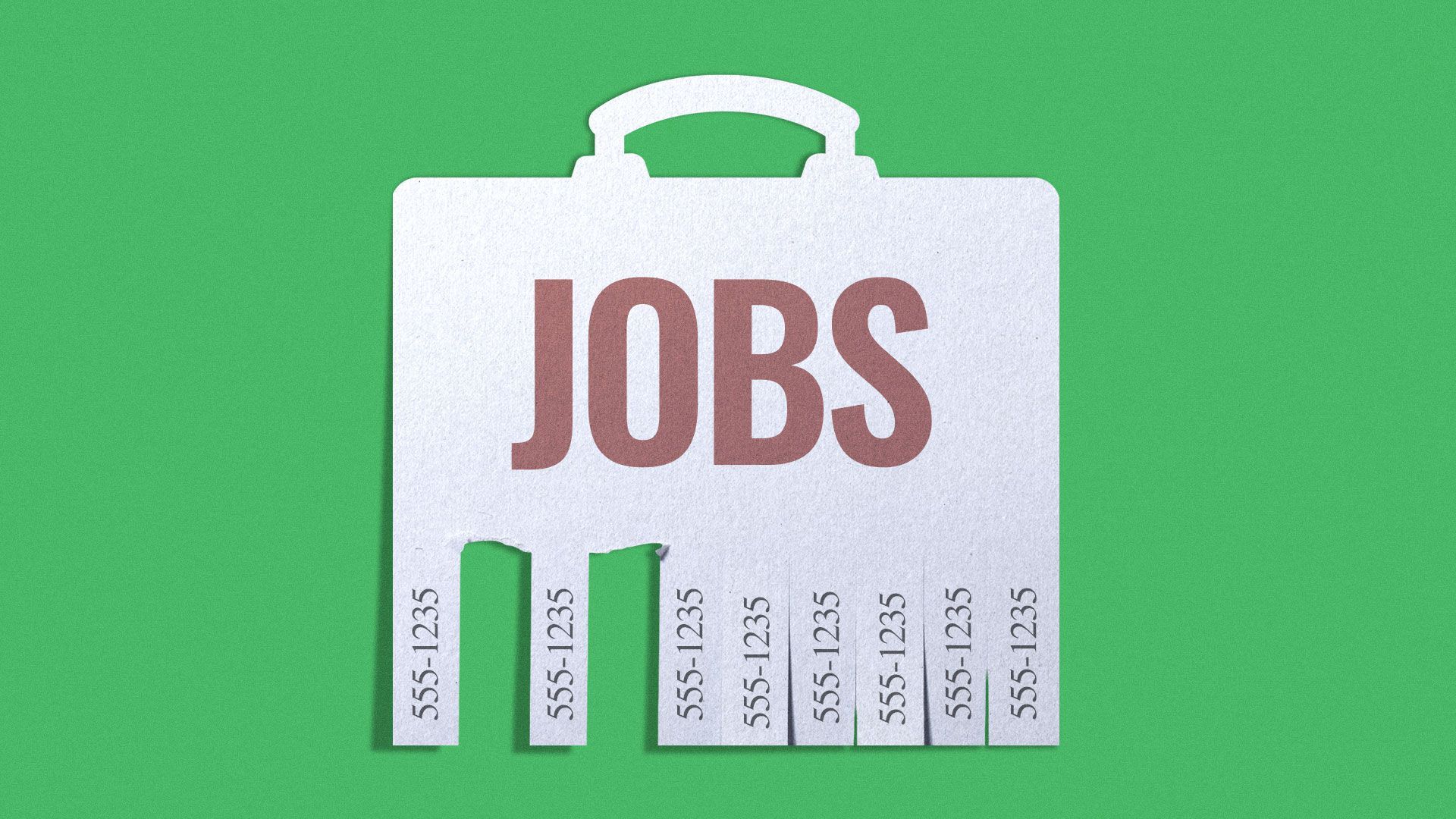| | | | | | | Presented By OurCrowd | | | | Axios Markets | | By Dion Rabouin ·Nov 02, 2020 | | Good morning! Was this email forwarded to you? Sign up here. (Today's Smart Brevity count: 1,238 words, 4.7 minutes.) 🎙 "It's close to midnight and something evil's lurking in the dark. Under the moonlight, you see a sight that almost stops your heart. You try to scream but terror takes the sound before you make it. You start to freeze as horror looks you right between the eyes. You're paralyzed." - See who said it and why it matters at the bottom. | | | | | | 1 big thing: The unemployment crisis hiding in plain sight |  | | | Illustration: Eniola Odetunde/Axios | | | | The fourth quarter is a major inflection point. The U.S. economy is moving out of its bounce-back recovery from the coronavirus depression and could be returning to slower growth and recovery or it could be moving toward a recession. On one side: The jobs report is expected to show employers added 625,000 jobs last month — demonstrating a labor market continuing to slow but still moving in a positive direction. On the other side: Layoff announcements picked up at the end of October, with ExxonMobil, Chevron, Charles Schwab and Raytheon all announcing the elimination of thousands of white-collar jobs. - Those followed major layoffs from Wells Fargo, Goldman Sachs, Salesforce, Allstate and WarnerMedia.
The intrigue: Rather than a panic-driven effort to cut costs and stay above water, these job losses are largely a result of companies reducing headcount after mergers and acquisitions or as part of a longer-term strategy. - Businesses have been positioning themselves for an increasingly competitive landscape by boosting productivity and reducing costs, so they've been cutting jobs and investing in new technology, as I wrote in September.
- "Almost every client that we deal with, irrespective of sector, is trying to drive cost down and make their products and services more affordable," Tim Ryan, U.S. chair and senior partner at PwC, said during a September call with reporters.
The big picture: We are seeing a second wave of job losses — this one more likely to permanently push millions out of the labor force, lower wages and leave long-lasting scars on the economy. By the numbers: In the first half of 2020, more than 3,600 companies filed for bankruptcy, according to legal services provider Epiq, and the pace has picked up since. - In June, just over 600 companies filed for bankruptcy protection, up 43% from June 2019.
- In September, 747 companies filed, a 78% increase over September 2019.
- "These commercial filings are primarily small businesses that do not have access to capital or stimulus," Deirdre O'Connor, managing director of corporate restructuring at Epiq said last month. "Unfortunately, those bankruptcies will continue to rise in the current economic environment."
|     | | | | | | 2. Catch up quick | | The U.S. reported a record high 99,300 infections Friday while the seven-day average of new cases surged almost 25% over the last week. (CNBC) Hospitalizations in Europe are skyrocketing, with about 75% of Germany's ICU beds occupied and French President Macron warning ICU patients in France could reach 9,000 in two weeks (from 3,156 on Thursday). Belgium and Switzerland also predict hospitals could reach capacity in a week or two. (Bloomberg) Huawei is working on plans for a dedicated chip plant in Shanghai that would not use American technology. (FT) Oil prices dropped to a five-month low with a barrel of West Texas Intermediate for December delivery trading below $35 this morning. (Bloomberg) |     | | | | | | 3. Asia's recovery is helping its stock markets outperform the U.S. |  Data: FactSet; Chart: Axios Visuals Asia's improved economic outlook is helping push stock markets in the region ahead of U.S. equity indexes. - In fact, Asian equities are performing better even as markets sell off, which is normally highly negative for Chinese and other emerging Asian markets traditionally seen as more speculative and risky.
What's happening: MSCI's index of Asian equities excluding Japan has outperformed its index of U.S. stocks year to date as Asian companies have weathered the recent slowdown better. - It's a far cry from the beginning of September when U.S. stocks hit their recent peak and the American index was outperforming its Asian counterpart by nearly 9%.
Why it matters: The far better recovery from the coronavirus pandemic in Asian countries is helping their financial markets bounce and draw more capital. Between the lines: Asian stocks, and those in emerging markets overall, had strengthened more than comparable U.S. stocks as the dollar weakened earlier this year, but even in the face of recent dollar appreciation Asian stocks have held their ground. - Since Oct. 12, MSCI's index of Asian equity markets has outperformed MSCI's index of U.S. shares by more than 5% and outperformed MSCI's European bourse by more than 7%.
- MSCI's all-country world index (ACWI), excluding U.S. stocks, has outperformed its all-country index including U.S. shares during that time.
|     | | | | | | A message from OurCrowd | | OurCrowd creates pre-IPO investment opportunities for you | | |  | | | | Today, OurCrowd members can invest in Cyabra. As disinformation becomes increasingly threatening to global brands, media and governments, Cyabra reports that it's uniquely positioned to serve this potential $6.1 billion market. Interested in investing? Join OurCrowd. | | | | | | 4. Fed meeting eyed as central banks shift to more easing | | The Fed's meeting this week will carry extra significance after the European Central Bank all but promised it would further ease monetary policy this month, likely by cutting its already negative interest rates on deposits and adding to its already substantial quantitative easing program. Why it matters: Whether or not the Fed chooses to expand its QE program, as governors have hinted at in recent weeks, will have an impact on every asset as the Fed's decision not to add to its current slate of stimulative policies is becoming increasingly uncommon among global central banks. Watch this space: ECB president Christine Lagarde referred to the "recalibration" of the ECB's policy 20 times in her one-hour press conference, suggesting that the central bank could take even more unconventional steps to help stimulate the region's economy as it faces a second wave of coronavirus infections. - Policymakers at the Bank of Canada took the action many expected the Fed to take at its most recent policy meeting, shifting bond purchases through its QE program to longer-dated maturities.
- The Reserve Bank of Australia signaled that it plans to cut record-low interest rates again at its November meeting and add to its QE program.
|     | | | | | | 5. Fall of an empire |  | | | Illustration: Aïda Amer/Axios | | | | Axios' Felix Salmon writes: The decline of ExxonMobil has been remarkable in its magnitude and unexpectedness. Why it matters: While all major oil companies are facing troubles, Exxon has fallen the farthest, in large part because it has made the biggest bets on oil and gas — and the smallest bets on renewable energy. - While rival BP has recently promised to get to zero net emissions by 2050, Exxon has been doubling down on fossil fuels with moves like a spectacularly ill-timed $41 billion acquisition of XTO Energy in 2009 and its major expansion in the Permian Basin in 2017.
Driving the news: Exxon reported a loss of $680 million in the third quarter of this year, bringing its losses for 2020 as a whole up to $2.37 billion. (In 2008, by contrast, it made a profit of $46 billion.) - The company also announced it would shed up to 15% of its workforce over the next two years, including roughly 1,900 U.S. layoffs, mostly at its Houston HQ.
- By the numbers: Exxon and Mobil combined had 390,000 employees in 1980. By 2017, that number had shrunk to less than 70,000.
Losses and layoffs notwithstanding, Exxon is still spending roughly $15 billion on sending a $3.48-per-share dividend to shareholders this year. - Few if any analysts believe such a payout is sustainable. "We have doubts about the sanctity of the dividend longer-term," Edward Jones analyst Jennifer Rowland told Reuters.
Flashback: The oil giant was the largest company in the world, measured by market value, as recently as 2013. The big picture: Today, ExxonMobil is not even in the top 40 most valuable companies in America. It's losing money, cutting staff and stretching to maintain an unsustainable dividend. - The oil giant's market capitalization of $137 billion makes it smaller than Zoom ($139 billion), and only about a third of the size of electricity-powered Tesla ($385 billion).
- NextEra Energy, a power company with huge renewables assets, is also worth more than ExxonMobil.
- The most valuable company, Apple, is worth roughly 14 ExxonMobils.
Exxon has lost 54% of its value this year alone. That's some $163 billion. By contrast, Chevron is down 42%, or $95 billion, while NextEra is up 23%, or $26 billion. |     | | | | | | A message from OurCrowd | | VC in on successful IPOs of 2019 and 2020 launches pandemic fund | | |  | | | | OurCrowd's Pandemic Innovation Fund. The idea: From communication companies adapting to the new normal to med-tech to food security solutions, the fund's investments have potential for positive impact and superior returns. If you're interested in investing, you need to join OurCrowd. | | | | Thanks for reading! Quote: "It's close to midnight and something evil's lurking in the dark. Under the moonlight, you see a sight that almost stops your heart. You try to scream but terror takes the sound before you make it. You start to freeze as horror looks you right between the eyes. You're paralyzed." Why it matters: On Nov. 2, 1983, Michael Jackson released the song "Thriller" worldwide as a single. Nearly a month later he released the accompanying music video, directed by John Landis. It was the seventh and final single from the album "Thriller." | | | | Axios thanks our partners for supporting our newsletters.
Sponsorship has no influence on editorial content. Axios, 3100 Clarendon Blvd, Suite 1300, Arlington VA 22201 | | | You received this email because you signed up for newsletters from Axios.
Change your preferences or unsubscribe here. | | | Was this email forwarded to you?
Sign up now to get Axios in your inbox. | | | | Follow Axios on social media:    | | | | | |






No comments:
Post a Comment